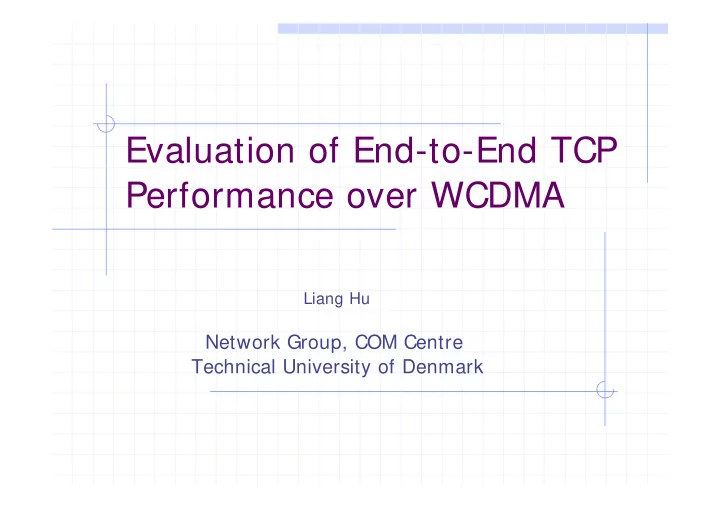

Evaluation of End-to-End TCP Performance over WCDMA Liang Hu Network Group, COM Centre Technical University of Denmark
Outline Recall background knowledge Why study TCP over WCDMA Performance Evaluation Split TCP Proxy Future work and expected results
Network Architecture in PS operation Background
Protocol Stack
Why study TCP over WCDMA In WCDMA, TCP performance is harmed by: Large Bandwidth Delay Product (BDP) e.g. take more RTT to reach BDP during slow start, low utilization TCP pipe. BDP= 4 kbytes or 24 kbytes when Delay= 500 ms, Bandwidth= 64 kbps or 384 kbps Higher Bit Error Rate in radio link � Packet loss rate could be up to 10% trigger non-congestion related TCP timeout or fast retransmit Spurious Timeout or Spurious fast retransmit, e.g. due to packet re-ordering in handover
The focus of this work Optimal link from TCP performance perspective High speed, low delay no non-congestion-related packet losses non-packet re-ordering Current solutions for improving TCP over WCDMA ARQ at RLC layer to avoid packet loss due to radio link errors RLC in order delivery to avoid Packet re-ordering Rather than impact of non-congestion related packet losses. this work focuses on the impact of Delay Bandwidth Product while incorporating the impact of Internet loss rate, It is expected that, i n slow start phase, TCP performs well in small BDP scenarios (e.g. 4kbytes) while in large BDP scenarios (e.g.24 kbytes), the TCP pipe can be easily underutilized for several RTTs
Performance Evaluation Application: FTP File Inter-Request time: exponential with mean= 30s
Simulation Parameter
Goal 1 : Impact of the file size RLC throughput VS File Size Simulation Results 160 In high bit rate DCH channel, small DCH 128 kbps 140 file size (e.g. web page) degrade DCH 64 kbps DCH 256 kbps RLC throughput dramatically. 120 RLC Throughput (kbps) (200% when file size from 200k to 100 50k) In low bit rate DCH channel, RCL 80 throughput is only slightly affected by file size 60 40 Reasons: 20 50 100 150 200 For a given time interval, the largrer File Size ( kBytes) file size, the less slow start phases
Goal 2: Impact of slow start initial counter RLC throughput VS TCP initial counter 85 Simulaton Results: 80 A large initial counter gives a higher 75 RLC throughput 70 In case of large bit rate DCH, the RLC throughput (kbps) performance gain is larger than the DCH 256 kbps 65 case of small bit rate channels (32% VS DCH 64 kbps 60 19%) 55 50 Reasons: 45 A larger initial counter can fill the TCP 40 pipe more quickly during TCP slow start 35 phase 1 1.5 2 2.5 3 3.5 4 initial counter (MSS)
Goal 3: Impact of loss rate in the Internet Imapct of Internet Loss Ratio Simulaton Results: 150 DCH 128 kbps For high bit rate radio link, the 140 DCH 256 kbps impact of internet loss rate is 130 significant to the RLC throughput. RLC throughput (kbps) 120 For low bandwdith radio link, the 110 impact of the Internet loss rate is minor. 100 90 Reasons: 80 In larger BDP scenario, the RLC 70 throughput degration (due to fast 60 0.01 0.02 0.03 0.04 0.05 0.06 0.07 0.08 0.09 0.1 0.11 retransmit triggger by packet loss in Internet Packet Loss Ratio Internet) is larger.
Goal 4: Impact of MaxDat at RLC Simulation Results Influence of RLC MaxDAT to TCP performance For a given BLER at link layer, there is a 160 MaxDAT value : above this value the optimal RLC thoughput can be 140 achieved; 120 However, a too large MaxDAT may RLC throghput (kbps) introduce long PDU transmission delay 100 to transport layer and trigger TCP spurious timeout 80 Reasons: 60 BLER 10% BLER 20% Interaction between of RLC 40 retransmission and TCP retransmission: RTT_TCP= (n* RTT_RLC+ C); 20 3 4 5 6 7 8 9 10 RLC layer Error Recovery is preferred MaxDAT than TCP end-to-end Error Correction
WCDMA network architecture with Split TCP proxy
Split TCP Proxy to improve large BDP Local retransmission for Fast Error Recovery is not the case in WCDMA In WCDMA, RLC layer ARQ is assumed to provides a reliable data delivery and hide unsuccessful transmissions of wireless links. Typical BLER 10% can be tolerant by RLC layer. What is the case in WCDMA? � Local ACK (pipelining two TCP connections) at Proxy to cope with large BDP � Larger initial congestion window for the TCP connection from Proxy towards UE e.g. up to maximum 10 MSS!
Schematic TCP transfer with and without PEP Assume the RTT from PEP to Client is larger than Server to PEP Without PEP, the server has to wait for the response time from the client before increase the sending window With PEP, pipelining for the two TCP connections can be effectively implemented
Current Work Compare the effects of with and without Proxy RLC throughput as a function of file size (0-1000k bytes) on various DCH channels (64kb/s,128kb/s,384kb/s) RLC throughput as a function of BLER (0%-15%)
Expected Results Proxy gives more performance gain for high bit rate DCH Proxy gives more performance gain for larger file size both during slow start and fast retransmit
Question and Answer Thank you ☺
Recommend
More recommend